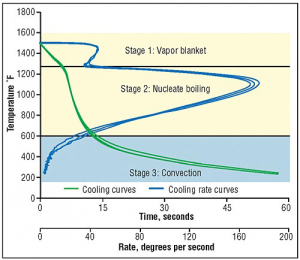Ask | Share | Grow™ - Question & Answer Community
Of the Members, By the Members, For the Members!
VacuumFurnaces.com is a Q&A community where vacuum furnace product and service suppliers connect with commercial and captive heat treaters to share their practical skills and know-how and to establish valuable relationships around niche topics of expertise with vacuum furnace end-users in operations, production, training, maintenance, marketing, sales, and engineering.

What does it mean when a unit of measurement is raised to a negative power?
When a number is raised to a negative power, in fraction form it would be described as one over that number and its exponent (positive). See below: This is also how negative powers work when applied to units. The well known constituent units of the Newton (Force) kg*m/(s^2) could also be written asRead more
When a number is raised to a negative power, in fraction form it would be described as one over that number and its exponent (positive). See below:
This is also how negative powers work when applied to units. The well known constituent units of the Newton (Force) kg*m/(s^2) could also be written as kg*m*s^-2, and so on. The negative exponent would represent the ‘per’, e.g. kilograms meters ‘per’ second squared.
See lessWhat are the benefits of argon gas quench?
ARGON is an inert gas used in gas quenching, thus it has certain inherent advantages over liquid quenching media. Namely: Gas quenched materials have cleaner surfaces and experience less oxidation [1] Gas quenching allows for less deformities and more uniform cooling [1] Gas quenching is safer [2] GRead more
ARGON is an inert gas used in gas quenching, thus it has certain inherent advantages over liquid quenching media. Namely:
There are other gas quenching media, however. One (popular) gas is nitrogen. Nitrogen is more often used because it is cheaper with a faster cooling rate [3].
However, nitrogen can decarburize [3] or nitride [4] sensitive steels, whereas argon does not. Furthermore, when compared directly to nitrogen over a handful of samples, in most cases, argon quenched steel had slightly or significantly better mechanical properties [3].
References
[1] https://www.generon.com/nitrogen-quenching-system/
[2] https://www.lindeus.com/industries/manufacturing-and-materials-processing/gas-quenching-and-inerting
[3] https://www.industrialheating.com/articles/93972-comparing-argon-and-nitrogen-cooling-in-vacuum-furnaces
[4]https://www.boconline.co.uk/en/images/Principles%20of%20Quenching%20and%20Cooling_tcm410-114391.pdf
See lessHow do you perform a helium leak test on a vacuum furnace?
I found an informative article about the same topic here: FURNACE LEAKAGE: HOW TO LOCATE SUCCESSFULLY VACUUM LEAKS An excerpt: "The vacuum chamber consists of a steel cylinder (vessel), with an access hatch and a jacket applied to all parts for the circulation of cooling water. Since this is an elecRead more
I found an informative article about the same topic here:
FURNACE LEAKAGE: HOW TO LOCATE SUCCESSFULLY VACUUM LEAKS
An excerpt: “The vacuum chamber consists of a steel cylinder (vessel), with an access hatch and a jacket applied to all parts for the circulation of cooling water. Since this is an electrically powered furnace, with a high-temperature thermal chamber and elastomer sealing gaskets, the water that cools the vessel and the associated components keep each surface at a low temperature (less than 150°C).” Continue Reading >>
Source: TAV Vacuum Furnaces
See lessWhat is a vacuum furnace bakeout?
Bake-out is a process which is meant to remove contaminants from components so that high vacuum can be achieved in treatment, and to prevent impurities. To remove these unwanted compounds, engineers perform bake-outs at various high temperatures (these can range from 120 degrees Celsius up to 400 deRead more
Bake-out is a process which is meant to remove contaminants from components so that high vacuum can be achieved in treatment, and to prevent impurities. To remove these unwanted compounds, engineers perform bake-outs at various high temperatures (these can range from 120 degrees Celsius up to 400 degrees Celsius).
The volatile compounds (such as vapor from components, or external particulate matter from humans or the environment) are driven off of the component during the period of heating. The volatile particles are then removed by the vacuum pump.
References:
Vacuum Bake Out: Its Importance and Implementation
courtesy of Vacuum Science World
https://www.vacuumscienceworld.com/blog/vacuum-bake-out
See lessWhat are the 3 stages of quenching?
The 3 stages of quenching are the Vapor Stage, the Boiling Stage, and finally the Convection stage. These stages are in reference to the interaction between the quenchant and the component being cooled. Vapor Stage: In this stage the super-heated component immediately vaporizes the quenchant. The gaRead more
The 3 stages of quenching are the Vapor Stage, the Boiling Stage, and finally the Convection stage. These stages are in reference to the interaction between the quenchant and the component being cooled. Vapor Stage: In this stage the super-heated component immediately vaporizes the quenchant. The gaseous quenchant now surrounds the component in a thin sheet, and the liquid quenchant is no longer in contact with the component and the heat therefore slowly seeps out of the component by radiation and limited conduction. Boiling Stage: As the vapor insulation degrades and collapses, the component begins to boil the quenchant. Due to the direct contact with the liquid quenchant, cooling occurs quicker than the vapor stage. Eventually, as the heat diffuses into the liquid, the interface temperature drops below boiling and the convection stage begins. This is a similar principle to that which allows this to occur (see video). This is called the Leidenfrost Effect (https://en.wikipedia.org/wiki/Leidenfrost_effect#:~:text=The%20Leidenfrost%20effect%20is%20a,the%20liquid%20from%20boiling%20rapidly.) Convection Stage: Finally, the convection stage occurs after boiling has ceased and the heat can only be transferred by convection. The rate of cooling gradually decays as the system approaches equilibrium. Please see the graphical illustration below. Image courtesy of Globalspec.com
Image courtesy of Globalspec.com
References: Understanding the Cooling Curve Test by D. Scott MacKenzie courtesy of Thermal Processing Magazine https://www.houghtonintl.com/sites/default/files/resources/article_-_understanding_the_cooling_curve_test_0.pdf
See less